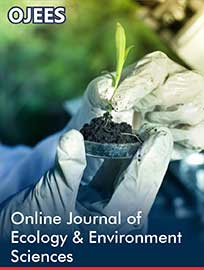 Research Article
Research Article
Stock Assessment and Conservation of Fisheries Resources in the Bay of Bengal: Policy Implications for Sustainable Development of the Blue Economy
MH Rashid1, Sheikh Md Fakhrul Islam2* and SM Bokhtiar3
1Chief Scientific Officer, and Project Director, Project Implementation Unit (PIU), National Agriculture Technology Project2, Bangladesh Agricultural Research Council (BARC) and World Bank
2Professor, Bangabandhu Sheikh Mujibur Rahman Agricultural University, Salna, Gazipur, Bangladesh and National Consultant of Policy Brief, PIU, BARC
3Executive Chairman, BARC, Farmgate, Dhaka, Bangladesh
S.M. Fakhrul Islam, Professor (Retired), Bangabandhu Sheikh Mujibur Rahman Agricultural University, Salna, Gazipur, Bangladesh.
Received Date: June 06, 2023; Published Date: June 16, 2023
Abstract
The marine area of the Bay of Bengal (BoB) of Bangladesh is one of the world’s 64 Large Marine Ecosystems. The entire shelf area of Bangladesh (up to 200 m depth contour) covers about 70,000 km2. The BoB is very rich in fish and shrimp species biodiversity. Around 511 marine species together with shrimps are available within Bangladeshi territories of which 100 important species of 20 fish families are highly commercial, contributing about 82-87% of the total demersal exploitation in the country. The potential of the coastal fisheries sector has not been rationally harvested. Rather the resources have been over-exploited, and as a result, the stocks of several important fish declined. Climate change also affected fishery production in marine ecosystems. Throughout and subsequent to the Rio +20 process there has been a growing appreciation that the world’s Oceans and Seas require more coordinated action. Healthy oceans are essential for global food security, livelihoods, and economic growth to address the world’s big challenge of the 21st century to feed 9 billion people by 2050 in the face of climate change. The Government of Bangladesh also prioritized investment for the development of the blue economy for food security and poverty reduction. The present study was conducted to assess the stock of commercial fish species of the Bay of Bengal (BoB) to ensure maximum sustainable yield for assisting the livelihood of the highest number of fishers for sustainable management of marine fisheries and identify the major man-made and climatic threats/factors to fisheries resources in the BoB using both primary and secondary data. The study revealed that the country has a total of 740 marine fish species in the BOB. Growth parameters, size at sexual maturity, and optimum catchable length of 15 commercially important marine fishes were estimated of which 4 species had balanced exploitation, 3 species were over-exploited, and the rest 8 are under-exploited. The analysis of gene diversities indicated that the studied fishes have experienced population expansion after a period of low effective population size, except for two species, M. cordyla and L. calcarifer for which the gene diversities were also low. This result implies that these two fish species of Bangladesh have experienced a recent bottleneck. Immediate conservation measures should be taken for these two species. Fishing with destructive fishing gears in seas was found to be a man-made cause or threat for declining of commercially important marine fishes in the BoB. The results of the study contributed to the management and policy strategies of Marine Fisheries to develop the Blue Economy. The government needs to formulate a policy for sustainable harvest and conservation of fisheries in the Bay of Bengal and some key policy actions are suggested for a healthy eco-system and sustainable management of marine fisheries resources.
Keywords:Blue economy; Marine eco-system; Stock assessment; Sustainable fisheries resources management; Policy actions
Introduction
Importance of the blue economy
Bangladesh has received entitlement to 118,813 sq. km in the Bay of Bengal comprising her territorial sea and Exclusive Economic Zone through the settlement of maritime border disputes with neighboring states Myanmar and India. Taking into account major river inlets and estuaries, which are together very much a part of the marine ecosystem, the total marine waters of Bangladesh stands at 121,110 sq. km of which coastal waters and the shallow shelf sea constitute about 20% and 35% respectively, the rest (45%) lying in deeper waters.
Globally the essential role of fisheries and aquaculture of the blue economy for food security and nutrition in the context of climate change and the employment of millions of people has been recognized. Also, biotechnology and marine genetic resources have great potentials to be used for the preparation of antibiotics and drugs. Marine biotech has the potential to address a suite of global challenges such as sustainable food supplies, human health, energy security, and environmental remediation. Marine genetic resources like bacteria are a rich source of potential drugs. In 2017 there were over 36 marine-derived drugs in clinical development, including 15 for the treatment of cancer.
There are 511 fish varieties alone besides snails, shellfish, crabs, sharks, octopuses, and other animals in the Bay of Bengal (BoB). It is estimated that Bangladesh catches only 0.70 million tons of fish every year out of the total 8.0 million tons of fish available in the BoB. It is worthwhile to mention that 15.0% of the protein is provided from sea resources for people across the world. Marine fisheries contribute 15.05% of the total fish production of Bangladesh [1]. Besides, on average, 81.0% of international tourists visit Cox’s Bazaar. Kuakata Beach is now the second most important tourist spot. As many people depend on oceans for their livelihood and food, increased efforts are needed to save ocean resources.
Bangladesh is yet to assess the true potential of its offshore gas prospects. Bangladesh could also have gas fields in its area of the sea. Bangladesh possesses some gas fields in the land and like Myanmar, Bangladesh may have the potential to get more gas fields in the sea which may add to the total reserve of gas of the country. Besides, oil and gas, sea salt, ocean renewable energy, blue energy (osmosis) and biomass, aggregates mining (sand, gravel, etc.), and marine genetic resource should get more attention as ocean resources. Therefore, this plenty of potential may contribute to our sustainable economic development in the future.
Bangladesh is yet to assess the true potential of its offshore gas prospects. Bangladesh could also have gas fields in its area of the sea. Bangladesh possesses some gas fields in the land and like Myanmar, Bangladesh may have the potential to get more gas fields in the sea which may add to the total reserve of gas of the country. Besides, oil and gas, sea salt, ocean renewable energy, blue energy (osmosis) and biomass, aggregates mining (sand, gravel, etc.), and marine genetic resource should get more attention as ocean resources. Therefore, this plenty of potential may contribute to our sustainable economic development in the future.
The objective of the Blue Economy initiative is to promote smart, sustainable, and inclusive growth and employment opportunities in Bangladesh’s maritime economic activities in the short, medium, and long-term time frames. The Blue Economy initiative specifically aims to promote synergies and foster framework conditions that support specific maritime economic activities and their value chains. The extensive review and analysis of Blue Growth potential have confirmed the potential of the Blue Economy as an untapped resource. To realize the necessary international cooperation and support to elevate the Blue Economy to the international sustainable development agenda, Bangladesh amongst the coastal countries has targeted the process leading up to the first International Workshop on Blue Economy in 2014 and then the second one in 2017 in Dhaka.
Emphasizing the importance of an ocean-based economy The Honorable Prime Minister of Bangladesh Sheikh Hasina (on 1st September’2014 in an International workshop on Blue Economy at Dhaka) emphasized the marine-based economic activities and management of sea and its resources through the “Blue Economy”, mentioning that such activities could create a new horizon for the development of a coastal country like Bangladesh. Full development and endorsement of the proposals by the Government constituted the next step in securing international momentum for and acceptance of, the Blue Economy as an approach distinct from, but mutually supportive with, the general economy. Hon’ble Prime Minister emphasized in the workshop that the Blue Economy could play an important role in the economic upliftment of the country in the context of poverty alleviation, ensuring food and nutrition security, and combating climate change impacts. Underlining the Blue Economy as a window of opportunity for development, the Prime Minister expressed her resolve to turn the Bay of Bengal into a hub of economic development and prosperity; and observed that marine resources and services could significantly contribute to the development of potential sectors. She, however, identified the lack of skilled human resources, institutions, and technology as a key challenge for Bangladesh to effectively utilize marine resources. She also maintained that Bangladesh had already accorded priority to the fishery. She re-affirmed Bangladesh’s commitment to conservation and balanced development of natural resources ocean keeping the integrity of environmental and bio-diversity aspects while pursuing development for the people of the country.
There is no doubt that sea-related subjects like the expansion of international trade, use of marine mineral resources for long-term energy security, proper management of marine fish resources, and protecting the marine environment and bio-diversity would determine Bangladesh’s future development and economic growth. Today, 90% of the country’s trade is transported through the sea. The fish stocks and other inorganic resources in the Bay of Bengal can contribute greatly to our economy. Bangladesh earns substantially by exporting marine fish. It is now more appropriate than ever to rely on ocean resources and management of such resources through the concept of Blue economy.
Present status of marine fisheries resource
Almost all of Bangladesh’s marine fishing is carried out in shallow and shelf waters, beyond which no fishing is being currently done due to a lack of vessel capacity and appropriate fishing technologies. The marine area of BoB of Bangladesh is characterized by a semi-enclosed tropical basin. It is one of the world’s 64 Large Marine Ecosystems. The entire shelf area of Bangladesh (up to 200 m depth contour) covers about 70,000 km2. The BoB is very rich in fish and shrimp species biodiversity. Around 511 marine species together with shrimps are available within Bangladeshi territories of which 100 important species of 20 fish families are highly commercial, contributing about 82-87% of the total demersal exploitation in the country. About 255 trawlers, 67669mechanized and non-mechanized boats are engaged in fishing. Pelagic and deep-sea resources are still untapped. In the year 2017-18, total fish production from Marine sources was 6.55 lac metric MT. Furthermore, an abundance of pelagic fishes, e.g., 7 species of Tuna and Skipjack, 4 species of Mackerel, and 14 species of Sharks and rays are also found. About 36 Species of Shrimps have been recorded from the marine water of Bangladesh. However, accurate species/stocks or unit-stock identification is very crucial both in the context of monitoring and conserving the fish species in any habitat.
Catch or production from open-water capture fisheries have been declined abruptly in Bangladesh due to environmental degradation, climate change, and numerous anthropogenic activities such as indiscriminate catching of juveniles, killing of spawners during peak spawning season, pollution from various sources, constructions of barrage and dams, siltation, etc. Nevertheless, the total fish production, especially from the culture and marine catch of Hilsa has increased in recent years due to the banning of harvesting it during the breeding and growing period of Jatka [1]. In addition, for the last few years, the catch of marine fish has increased progressively, indicating a viable alternative for more and more fish production to meet the demand of the expanding population of the country and increasing export earnings. The potential of the coastal fisheries sector has not been rationally harvested. Rather the resources have been over-exploited, and as a result, the stocks of several important fish declined. The sustainable exploitation of marine fishery resources is constrained by
a) A lack of knowledge of the species-wise current stock, the location of the breeding ground, and the grow-out areas for each genetic stock (i.e., unit stock), and the potential maximum sustainable yields by species, season and location;
b) Over-fishing.
Climate change unswervingly affected fishery production in marine ecosystems along many pathways. Fish growth, reproduction, distribution, migration, and stocks are mostly affected by temperature, rainfall, and hydrology. Climate change is likely to badly affect marine fishes and shrimps in Bangladesh. Information on the fish stock assessment is crucial for studies and inference on stock status including structure, natural fishing, and total mortality and exploitation, as well as the possible outcomes of different management alternatives. It helps to determine whether the abundance of a stock is below or above a given target point and whether the stock is overexploited or not. Besides, it also tells us if a catch level will maintain or change the abundance of the stock (Frank and Brickman, 2001) which ultimately helps for sustainable fisheries management of marine fishes and shrimps.
In order to manage the commercially important fishes effectively, it is also necessary to identify the exact reason for declining in relation to their life history traits, i.e., population parameters and stock status. For sustainable exploitation, conservation, and management of renewable marine resources, investigations on the spawning seasons of commercially important marine fishes in the BoB (Bangladesh) is an important option for the country. Several important commercial fish species of Bangladesh are reported to face the vulnerability of population decrease. When managing a species as a resource, assessment of genetic diversity and population structure can be a vital tool for maintaining a productive fishery (Seeb et al. 1990).
The different stocks also reflect genetic diversity and if a particular stock is fished to extinction or to very low levels, this genetic diversity may be lost. The stock will not readily be replenished from other stocks because of the genetic isolation, and therefore the production it was generating will also be lost, leading to a permanent or at least long-term loss of benefits. Fisheries management should therefore attempt to address each stock separately and to ensure sustainable use of each stock and not just of the population as a whole. Besides, it is also important to know the genetic diversity of each of the existing populations of fish. Genetic variability influences both the health and long-term survival of populations because decreased genetic diversity has been associated with reduced fitness, such as high juvenile mortality, diminished population growth, reduced immunity, and ultimately, higher extinction risk.
The policy context
Throughout and subsequent to the Rio +20 process there has been a growing appreciation that the world’s Oceans and Seas require more in-depth attention and coordinated action. This has been reflected in various initiatives inter alia the UNDESA expert group meeting on Oceans, Seas, and Sustainable Development, the work of the Global Ocean Commission, the Global Partnership for Oceans, and the prominence given to oceans and seas in the UN Action Agenda. Healthy oceans are essential for global food security, livelihoods, and economic growth to address the world’s big challenge of the 21st century to feed 9 billion people by 2050 in the face of climate change, economic and financial uncertainty, and the growing competition for natural resources. This requires an integrated response and an urgent transition of the world economy towards a sustainable, inclusive, and resource-efficient path.
In 2012, the UN formulated a Blue Economy strategy to harness the potential of oceans, seas, and coasts for economic growth. The blue economy strategy was formulated with the objective to promote smart, sustainable, and inclusive growth and employment opportunities through utilization of the maritime resources. The United Nations’ 2030 Agenda for Sustainable Development and its 17 Sustainable Development Goals (SDGs) offer an integrative approach to shifting the world to a sustainable and resilient path. Food and agriculture are key to achieving the entire set of SDGs, and many SDGs are directly relevant to fisheries and aquaculture, in particular, SDG 14 (Conserve and sustainably use the oceans, seas, and marine resources for sustainable development). Anthropogenic activities directly and markedly reduced ocean productivity. Global Ocean Observing System (GOOS) and LME assessments show significant warming trends from which model projections 2040-2060 forecast a steady decline in ocean productivity. The implementation of sound management measures brings the promise of increased sustainable catches, and lower energy utilization and costs; thereby securing livelihoods and enhancing food security. At the United Nations Conference on Sustainable Development (UNCSD) held in Rio de Janeiro in 2012, the blue economy was viewed as an ocean economy that aims at the “improvement of human well-being and social equity, while significantly reducing environmental risks and ecological scarcities.
Bangladesh, making the transition to Blue Economy would require changes in their policy-regulatory-management-governance framework(s) and identification of various maritime economic functions. The blue economy would require poly support for ocean industries, such as fisheries, tourism, and marine transport, as well as new and emerging activities such as offshore renewable energy, aquaculture, seabed extractive activities, marine biotechnology, and bioprospecting. It is necessary to invest in human capital. Individuals need to be trained to be able to work in the blue economy, thereby harnessing the employment and development benefits of investing in innovative blue economy sectors.
Already, Bangladesh has taken steps to develop a supportive policy to flourish its Blue Economy in order to utilize its marine resources. Since 2015, the GoB has undertaken a number of consultations and workshops on the Blue Economy. In addition, The Seventh-Five Year Plan (7FYP) of Bangladesh has mentioned twelve actions for maintaining a prosperous and sustainable Blue Economy, which include fisheries, renewable energy, human resources, transshipment, tourism, and climate change among others. Moreover, in 2017, the “Blue Economy Cell’ under the Ministry of Foreign Affairs (MoFA), GoB has been established with the mandate to coordinate Blue Economy initiatives across sectoral ministries. The Blue Economy has the prospect to contribute Bangladesh’s economy on a much higher level. Twenty-six potential Blue Economy sectors have been identified by the MoFA which include fishery, maritime trade and shipping, energy, tourism, coastal protection, maritime safety, and surveillance for the development of blue economy in Bangladesh.
The 7th Five Year Plan took 12 appropriate actions/programs to create and maintain prosperous and sustainable blue economy bases during the 7th plan period. These include fishing, aquaculture, marine culture, renewable energy, human resources development, maritime industries, new technologies and methods, marine tourism, eco-systems, shipping, ship-building, climate change, inland river systems, and inland shipping, building a solid science, research, and education base and more establishment of marine educational institutions.
The Perspective Plan of Bangladesh 2021-2041, The Delta Plan 2100, and the SDGs were considered for preparation of the 8th Five Year Plan (8thFYP). The government set targets to bring down the poverty rate to 15.6 percent and the extreme poverty rate to 7.4 percent during the 8th FYP of Bangladesh (duration 2021-2025). The 8th FYP addressed the gap in issues relating to food security, nutrition, production sustainability, and the impact of climate change on agriculture that call for cooperation from the development partners, NGOs, the private sector, and agencies Government of Bangladesh (GoB).
The 8th Five Year Plan prioritized possibilities of domestic and international cooperation, using a blue economy for poverty reduction, creating employment opportunities in this sector, betterment of people, fishers, transportation and communications, possibilities and potentialities of private sector engagement or public-private partnership (PPP) programs for the blue economy exploration, environment sustainability, urban development in the coastal areas in light of rising sea level and extreme weather events, etc. It also prioritized the importance of research and extension for the generation and dissemination of technology to boost agricultural production through promoting intensification, diversification, and resilience to climate change. and ensuring efficient utilization of natural resources.
The GoB adopted Vision 2021 a long-term development strategy that aimed at transforming Bangladesh into a middle-income country by 2021. The implementation of Vision 2021 is being achieved through the National Perspective Plan (2010-2021). In both documents, the GoB has prioritized the achievement of nutritional requirements by 2021. The development vision for agriculture under the 7 FYP also aimed at ensuring food and nutritional security, sustainable intensification, and diversification of climate-resilient agricultural production. Its priorities were commercialization and livelihood improvement through technological innovations and linking the producing community with markets, both national and international.
Besides the 7FYP and 8FYP, the key guiding document for the development of the agriculture sector is the National Fisheries Policy 1998, which aims to enhancement of the fisheries resources and production; poverty alleviation through creating self-employment, and improvement of socio-economic conditions of the fishers; meet the demand for animal protein, achieve economic growth and earn foreign currency by exporting fish and fisheries products.
The National Food Policy (NFP 2006) mainly targeting women and children, aims to enhance purchasing power to increase access to food and to ensure adequate nutrition for all. NFP strongly acknowledges that adequate food availability, enhancing access to food and subsequent utilization of food for nutrition by the poor and distressed households.
The GoB also adopted the National Sustainable Development Strategy (NSDS 2010-21), which identifies strategic priority areas (sustained economic growth, development of priority sectors, social security and protection, environment, natural resources, and disaster management) along with cross-cutting areas (disaster risk reduction and climate, good governance and gender) with a view to achieving the strategic vision and addressing long-term sustainability of productive resources.
Study Methodology
The Fisheries Division of Bangladesh Agricultural Research Council (BARC), the Department of Fisheries of Rajshahi University, and the Department of Fisheries Biology and Genetics of Sher-EBangla Agriculture University jointly implemented a research project: “Stock Assessment of Commercially Important Fishes in the Bay of Bengal Through Multi-model Inferences and Molecular Markers: Management Policy Implications Considering the Emerging Climate Change,” funded by National Agricultural Technology Project2, PIU, and BARC funded by World Bank, during 2019 to 2022. The objectives of the study were:
(i) To determine and categorize the stock of commercial fish species of the Bay of Bengal (BoB) to ensure maximum sustainable yield for assisting the livelihood of the highest number of fishers,
(ii) To categorize the fish stocks and to assess its status through multiple models in the BoB,
(iii) To upgrade the livelihoods of fishers through sustainable management of marine fisheries,
(iv) To identify the major anthopogenic and climatic threats/factors to fisheries resources in the BoB.
The study conducted a stock assessment of selected 15 commercially important marine fish species through Multi-Model inferences. It also investigated the population genetic structure (i.e. genetic stock assessment) of 15 commercial marine fish species using mitochondrial DNA as an effective molecular marker. A joint survey was conducted to identify major threats to the marine fisheries of Bangladesh especially caused by human interference besides climate change. The study dealt with the ‘rapid assessment of fisheries stocks by species in the economic zone of Bangladesh which was the ‘first priority’ of the Fisheries Sub-Sector of the 7th Five Year Plan of Bangladesh with aiming to achieving the SDGs.
The study was conducted in the BoB, Bangladesh covering Khulna, Barishal, Chattogram, and Cox’s Bazar regions. Fish species in BoB were enlisted based on commercial small and large-scale fishers’ catches at different landing sites and from different sampling stations, areas, and sites of the proposed study using hired fishing boats. Collected fishes were categorized based on economic point of view into
(i) Commercial edible stock,
(ii) Commercially exploitable stock,
(iii) Non-commercial stock through a survey with a structured
questionnaire and Focus group discussion (FGD). Additionally, fish species were categorized based on fishing pressure into(iv) (i) Over-exploited stock, (ii) Under-exploited stock, (iii) Balanced stock, and (iv) Virgin stock.
Monthly samples of 15 selected commercially important marine fish were collected using hired commercial fishing boats/fishers. Catches data of marine commercial fishes were collected from Bangladesh Fisheries Development Corporation (BFDC) landing center, Pathorghata, Barguna. The interview was conducted with the local fishers, boatmen & owners, aged group, businessmen, and exporters over the major fish landing centers of Bangladesh through a pre-tested structured questionnaire for gathering local knowledge of commercially important marine fish their fishing, nursery, spawning grounds and spawning season, catch trends, etc. The landing sites were visited daily in all seasons considering the lunar cycle and species availability. In addition, water quality parameters were monitored using Multi-Meter Digital Meter. Climate data (rainfall (mm), water & air temperature (°C) were collected from the Bangladesh Meteorological Department.
The preserved specimens were then taken out one by one later to be weighed, measured, and sexed (Plate 2). All specimens of fish were sexed by morphometric characteristics and gonad observation under a binocular microscope. For each individual, various lengths including total length (TL), Standard length (SL), and fork length (FL), body depth (BD), pre-dorsal, post-dorsal, anal length were measured to the nearest 0.01 cm, and body weight (BW) was taken with 0.01 g accuracy.
The population structure for the commercially important fish was constructed using 1 cm intervals of TL. Based on Hasselblad’s maximum-likelihood method (Hasselblad, 1966), the normal distribution was fitted to TL frequency distributions through Microsoft® Excel-add-in-Solver.
Analysis of different biological aspects including fish category, relative growth, condition factor, growth pattern and form factor, sexual maturity, spawning- and peak-spawning season, growth parameters, performance and life span, recruitment pattern and length and age-at-first recruitment, stock assessment (exploitation rate and maximum sustainable yield, MSY) etc. were done.
Furthermore, necessary data and information for threats to biodiversity and its conservation were collected through the survey on the fishers, fish traders, teachers, students, researchers, Government and NGO personnel, and experienced persons related to fisheries sectors, and available literature. In addition, data of climate was collected from literature, websites, and meteorological station.
Collection of samples and DNA data for genetic stocks, diversity, and divergence: For stock assessment by molecular approach, about 100 samples of each species of ten marine fishes (Table 1 and Photo 1) were collected between October 2020 and April 2022 mainly from the coast and rivers of two ecological regions of the coastal areas of Bangladesh (Figure 2): the South-east (Borguna-Khulna-Patuakhali, KP) coastal zone and the South-west (Chattogram-Cox’s Bazar, CC) coastal zone based on different physicochemical characteristics of habitat (KP: high brackish water area with a dense clayed particle in river and estuaries; CC: sandy area with more clear saline water river and estuaries), and biology of species (e.g. migratory, amphidromous, anadromous, etc.). For amphidromous (migrate between freshwater and marine water but not for breeding purposes) or anadromous fish, samples were collected from coastal rivers. Fish/tissue samples or DNA sequence data of other seas (Figure 3) in the Indian Ocean region (e.g. Southern BoB, Andaman Sea, Arabian Sea, Persian Gulf, etc.) and South-west Pacific (e.g. South China Sea, Gulf of Thailand, etc.) were collected by personal communication and collaboration with foreign scientists, and from the scientific literatures such as Zafar et al. (2012), [2-6], Xu et al. (2014).
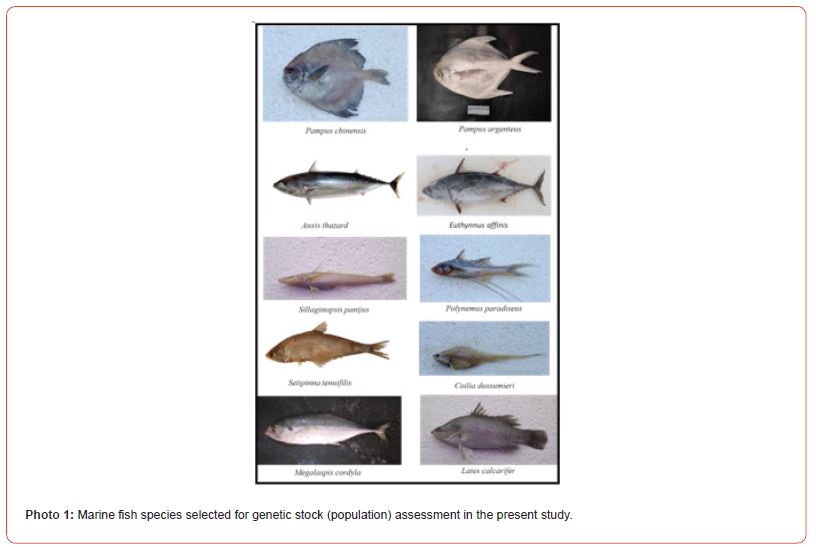
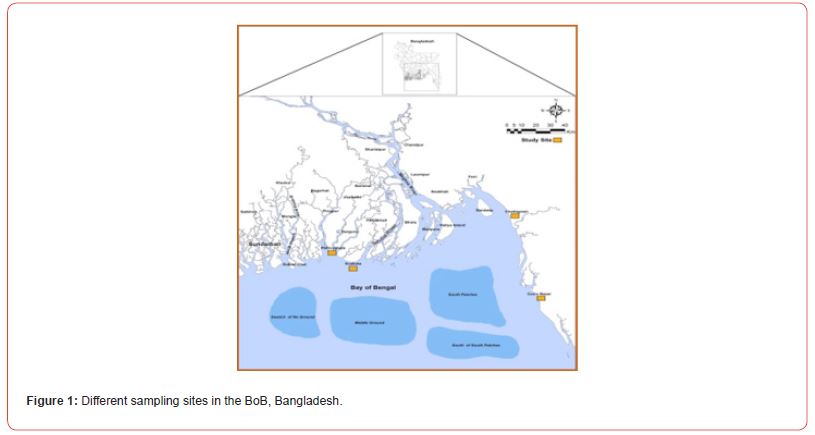
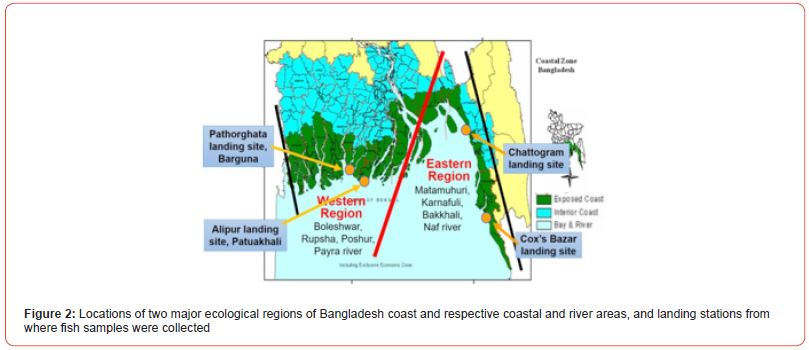

Table 1: List of the commercially important marine fish species selected for genetic stock assessment.

Sampling information on genetic stock assessment of P chinensis in BoB, BD & other sea areas
The fish species P chinensis (Chinese pomfret or Rupchanda) is distributed to Indo-West Pacific: Persian Gulf to eastern Indonesia, north to Japan. This fish occurs seasonally singly or in small schools over muddy bottoms; may enter estuaries. We collected 92 samples from two ecological regions of the coastal area of the BoB (BoB), Bangladesh. Besides, for comparing the Bangladeshi populations of the BoB with other marine areas, mtDNA D-loop sequences of 84 samples from 4 regions viz. Sonmiani and Omara of Pakistan in the Arabian Sea (ArS); Beihai, and Xiamen of China in the South China Sea (SCS) (Figure 4 and Table 2) were collected and analyzed.
Table 2: Sampling information for P. chinensis used in the present study.

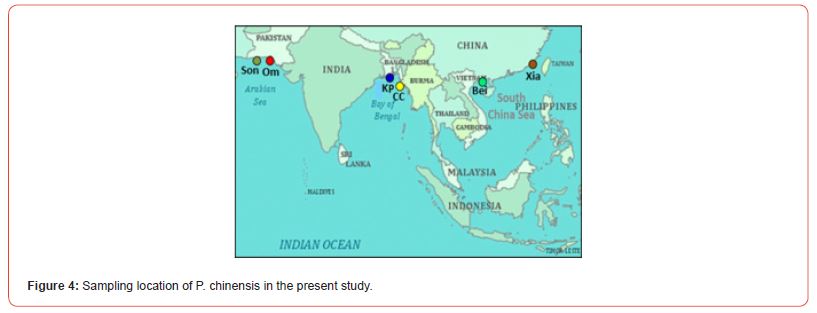
Sampling information on genetic stock assessment of A thazard in BoB and other sea areas
The fish A thazard (Frigate tuna or Tuna) is a marine, pelagic- neritic and oceanodromous species. It is distributed to the Atlantic, Indian, and Pacific (Western Central) ocean regions. It is a highly migratory species. Fish samples of A. thazard and its mtDNA d-loop sequence data were collected from five localities over its range of distribution including Patharghata (PG) and Cox’s Bazar (CB) of the northern BoB, Bangladesh; Pondicherry (PO) and Vizag (VI) of Southern BoB; Veraval (VE), Ratnagiri (RA), Kochi (KO), Kavaratti (KA), Tuticorin (TU) of Arabian Sea; & Port-Blair (PB) of Andaman Sea (Figure 5 & Table 3).
Table 3: Sampling information for A thazard used in the present study.


Results and Discussion
Availability of marine fish species in the Bay of Bengal (BOB)
To determine the actual number of available marine fish species in the BoB of Bangladesh, we have made a checklist reviewing the valid publications and literature covering about a 50-year span from 1970 to 2020 along with our observation which revealed that the BOB of Bangladesh has a total of 740 marine fish species in its marine environment.
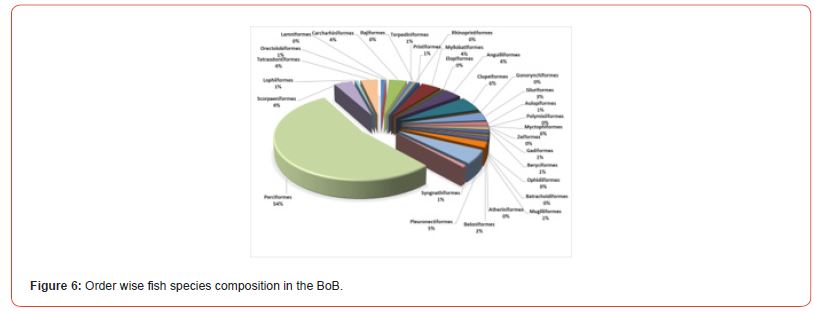
Exploitation status of commercially important marine fishes
The list of commercially important marine fishes selected for the present study is illustrated in the Photo 2. Growth parameters, size at sexual maturity, and optimum catchable length of 15 commercially important marine fishes were estimated to calculate maximum sustainable yield (MSY) and used these information to find out the mesh size of fishing gear. The study results indicated that the exploitation rate of 15 commercially important 4 marine fishes P. heterolepis, S. panijus, H. nehereus and T. setirostris had balanced exploitation; while 3 fishes L. calcarifer, P. paradiseus, A. leiogaster was over-exploited; and the rest 8 are under-exploited.
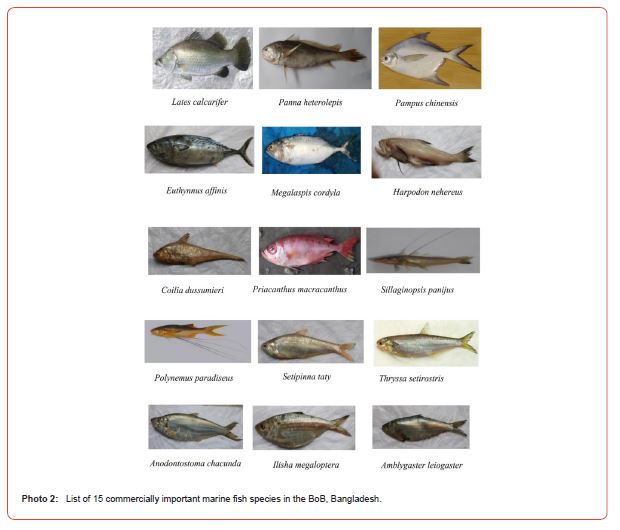
The analysis of genes diversities indicated that the studied fishes have experienced population expansion after a period of low effective population size, except two species, M. cordyla and L. calcarifer for which the gene diversities were also low. This result implies that these two fish species of Bangladesh have experienced a recent bottleneck. Immediate conservation measures should be taken for these two species.
The information generated on the spawning and peak spawning season of commercially important marine fishes of the BoB indicated that the requirement of amendment of the existing fishing banning period of GoB from “20th May to 23rd July” to a newly proposed period of 15th April to 30th June each year”;
Table 4: Status of commercially important marine fishes in the BoB according to IUCN Bangladesh (2015) and IUCN World-wide (2022).

Major anthropogenic and climatic threats/factors to fisheries resources
The survey revealed that fishing with mosquito net in estuaries and mangrove and fishing through a “Behundi” net in seas was found as the major anthropogenic causes or threats for declining of commercially important marine fishes in the BoB. Besides, catches of fry, fingerlings, and jatka (young Hilsha fish), poison fishing in mangroves, illegal fishing by India and Myanmar’s fishers, and use of destructive fishing gears (e.g. China net, Behundi nets in rivers/ channels’ mouth) for capturing marine brood fish were identified as major causal factors for declining marine fishes.
Table 5: Major man-made and climatic threats/ factors to fisheries resources in the BoB, Bangladesh.
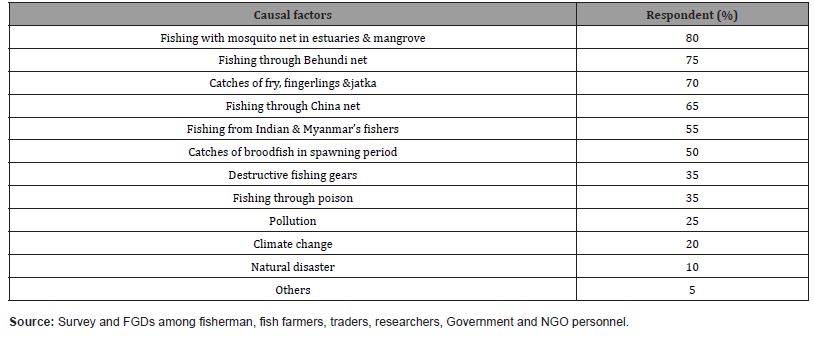
Another study Rahman, et al. [7] also found that indiscriminate fishing is increased through an introduced fishing gear namely a China net. According to this study fish biodiversity is declining due to a combination of over-exploitation, environmental degradation, pesticides, and aquatic pollution, the spread of diseases, uncontrolled introduction of exotic fishes, destruction of breeding grounds, excessive water abstraction, siltation, various ecological changes in its natural habit and lack of proper management and subsequent ship breaking industry in the BoB are the key causes for destroying of marine fisheries resources of Bangladesh [8-12].
Conclusion and Policy Implications
On the basis of the findings of the present study following conclusions can be drawn:
• A total of 740 marine fish species enlisted from the BoB of Bangladesh;
• Exploitation rate of 15 commercially important marine fishes indicated that only 4 species have balanced exploitation while 3 species were over-exploited; and the rest 8 are under-exploited;
• The analysis of genes diversities indicated that the studied fishes have experienced population expansion after a period of low effective population size, except two species, M. cordyla and L. calcarifer for which the gene diversities were also low. This result implies that these two fish species of Bangladesh need Immediate conservation measures.
• Information generated on the spawning and peak spawning season of commercially important marine fishes of the BoB indicated requirement of amendment of present fishing banning period of GoB from “20th May to 23th July” to a newly proposed period of “15th April to 30th June each year”;
• Fishing with harmful nets in estuaries & mangrove and fishing in seas was found as the major man-made causes or threats for declining of commercially important marine fishes in the BoB.
• Some river populations of coast dwellers amphidromous fishes will require separate monitoring and management strategies for conservation because the fish population of some rivers is genetically distinct. Overfishing in any of these rivers may cause the extinction of its fish stock.
The implications of the study results are that government needs to formulate a policy on stock assessment, sustainable harvest, and conservation of commercially important fisheries in the Bay of Bengal with an increased investment to reduce over-exploitation and enhance fish productivity, employment generation, exports, food, and nutrition security for addressing climate change vulnerability, as well as meeting SDGs.
Five SDGs are relevant to the policy & strategic actions. These are SDG1: End poverty in all its forms everywhere; SDG2: End hunger, achieve food security and improved nutrition and promote sustainable agriculture, SDG 12: Sustainable consumption and production and SDG 13: Take urgent action to combat climate change and its impacts. The agriculture sector plays a vital role to meet the basic food need and ensure food and nutritional security. SDG 14: Life underwater: conserve and sustainably use the oceans, seas, and marine resources for sustainable development.
The National Sustainable Development Strategy (NSDS) has been suggested to face and meet the environmental challenges in the way to development. NSDS fulfills Bangladesh’s commitment to the international community to formulate and implement a sustainable development strategy addressing environmental issues.
The National Fisheries Policy 1998 emphasized for conservation of small-scale fisheries. Acceding to this policy fishing in the coastal areas will be demarcated for small-scale and large-scale fishing determined from the results of research, surveys, and information on commercial harvest and regulated by updated laws. The conservation of coastal and deep-water marine resources will be considered with importance on the basis of research results. Research and surveys will be conducted under regional and international programs to develop the capacity for using modern fish harvest techniques. The development vision of agricultural research of Bangladesh would be to generate demand-led green and climate-smart technologies/new knowledge suitable for highly productive agriculture. Evidence shows that agricultural R&D investment plays an important role in increasing productivity and growth.
Aligning with the existing policies of GoB following key policy actions is recommended:
Technology and knowledge generation
1. A nationally coordinated marine fisheries research program needs to be developed on stock assessment, harvest and conservation of commercially important fisheries in the Bay of Bengal, improvement of fishing gears, appropriate timing of fish sanctuaries, the culture of sea foods, fish processing, value chain development and minimization of post-harvest loss, sustainable eco-system development and reduction of pollution, livelihood improvement of fishers, etc.
2. Policy Research: Conduct research on future policies, strategies, and plans for the development of the blue economy from the year 2030 to 2040.
3. Coordinated approach: The fisheries Division of BARC will coordinate this program with the relevant NARS institutes, Universities< NGOs, and the private sector. A committee shall be prepared with the representative experts of these agencies. The MD of the Fisheries Division, BARC, would be the Chairman of this committee. The committee shall prepare an annual research plan, budget, and implement a research program.
4. A pool of experts needs to be prepared under the Fisheries Division of BARC. The BARC will coordinate this program with the relevant NARS institutes, Universities< NGOs, and the private sector. who will review, monitor and evaluate the progress and achievement of the coordinated national marine fisheries research program regularly through field visit and workshops.
5. Developing partnership and collaboration: Following the Blue Economy conquest statements reported by UNEP (2015) could be used for developing technology, research, and other collaboration in Bangladesh. It is necessary to promote collaboration, and partnership and adopt technical knowledge exchange programs through participation development partners, partnerships with other Blue Economy countries, GoB agencies, NGOs, and the private sector. Encouraging private sector investments in coastal mariculture; collaborating among the international community to end overfishing, effectively regulating harvesting and ending illegal-unreported-unregulated (IUU) fishing and destructive fishing practices; and supporting the countries in need on implementation of their science-based management plans towards the restoration of fish stocks to sustainable yield level; strengthening regional governance/ institutions in Areas Beyond National Jurisdiction (ABNJ) management.
6. Dissemination of research results: The generation of new knowledge and technology generation should be disseminated regularly through workshops conducted by relevant NARS institutes, DoF, media, publications, etc.
7. Capacity development: Develop the capacity of the farmers, fishers, and market actors through training and information sharing. Capacity-building needs to be approached and planned in regard to the adequate development of governance and institutional framework(s), effective legislative framework, participation of academic and research institutions, managerial-technical-technological capabilities, and qualified, comparable skills. Partnership(s) among and between stakeholders- within and across countries and oceans and seas and international systems-is critical in facilitating a greater flow of expertise, finance, and capacity to effectively reduce gaps e.g. support effective participation of those States in regional fisheries management and other exploitation techniques required sea resources. To date, UNCLOS provides the most widely accepted legal instrument in the governance of all aspects of oceans and seas, including marine resources.
8. Promote enhancing sustainable fishing capacity and creating alternative job opportunities; promoting sustainable management of marine fisheries; supporting artisanal communities access to information, technology, finance, regulation and governance processes with a view to securing them year-round livelihood from alternate sources.
9. Adopt effective measures to reduce the pollution of the environmental degradation and seawater for the Sustainable Blue Economy.
10. Promote processing and value addition by developing adequate cold storage and cool chain transportation system throughout the country to reduce post-harvest loss of marine fisheries.
11. Adequate infrastructural improvements are needed to enhance maritime and coastal tourism since the tourism industry has become an emerging source of national income.
12. Coordination and harmonization: Different ministries related to the blue economy shall be coordinated and harmonized with different plans for the successful implementations of blue economy policies in accordance with the goals and targets of SDG-14 within 2030.
Acknowledgement
None.
Conflict of Interest
No Conflict of Interest.
References
-
MH Rashid, Sheikh Md Fakhrul Islam* and SM Bokhtiar. Stock Assessment and Conservation of Fisheries Resources in the Bay of Bengal: Policy Implications for Sustainable Development of the Blue Economy. Online J Ecol Environ Sci. 1(2): 2023. OJEES.MS.ID.000506.
-
Mycobacterium ulcerans, Distribution of pathogens, Buruli ulcer, Climate change, Global positioning system, Potential reservoirs, Bioclimatic variables, Aquatic hemiptera, Topography, Stream accumulation.
-

This work is licensed under a Creative Commons Attribution-NonCommercial 4.0 International License.



